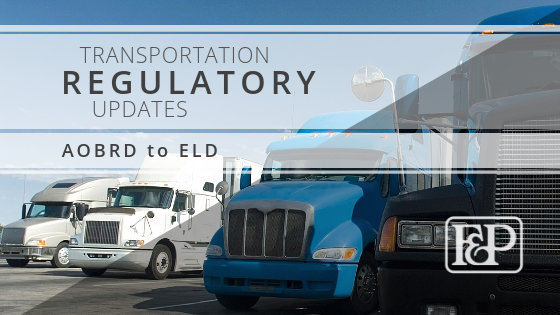AOBRD to ELD will not be as easy as it seems.
This transportation regulatory update courtesy of our valued partner Ryan Byers, President of Front Range Compliance Services, L.L.C.
By December 16, 2019, carriers that are using grandfathered automatic onboard recording devices (AOBRDs) will need to switch to electronic logging devices (ELDs). While these devices (and the associated back-office systems) are similar, there are differences that need to be considered when making the switch.
Drivers
Drivers will notice the difference as soon as they log into an ELD, as one key difference is the login procedure. When the driver logs into an ELD, if the device has any recent driving records that were not assigned to a specific driver due to the vehicle moving without someone being logged into the ELD (unassigned driving time), it must be offered to the driver. If the driver accepts it, the time is integrated into his or her records. If he or she denies the time, it will appear in the back office in the unidentified driver account as well as being visible as unassigned driving time on the driver’s device.
Also unlike AOBRDs, an ELD must switch to the driving status when the vehicle reaches no more than five miles per hour. Other changes drivers need to be aware of include:
- When and how to use the special driving categories (yard move and personal use);
- When and how to use the editing privileges the driver is provided with under the ELD rules; and
- How to transfer data directly to officers during a roadside inspection, using either telematics or local transfer.
Driver training
These changes will require extensive training. Errors made by drivers in daily operation will lead to violations on the road, extra work in the back office, and an increased exposure to violations during audits. One possible source for such training should be the carrier’s ELD vendor.
Drivers aren’t the only ones impacted
As well as impacting the drivers, the change will also impact the back-office (support) personnel. With ELDs, back office personnel will need to get used to:
- Assigning any incident of unassigned driving time to a specific driver or attaching a comment to it explaining why it could not be assigned.
- Being able to transfer specific ELD records directly to an investigator during an investigation or audit.
- Updating the in-house auditing methods related to operating over hours, spotting falsification, and spotting the misuse of editing and the special driving categories.
- Not using generic or “ghost” accounts (such as maintenance or yard driver accounts). Each account must have an actual person assigned to it, and each driver account must have the driver’s license number listed.
Plan and execute, don’t just hope for the best
As you can see, the switch from AOBRDs to ELDs is not going to be as easy as some believe. Simply installing the devices or allowing the existing devices to update at the last minute will cause chaos. As the chaos will be in the area of hours of service, it will lead to a lot of pain. A prime example of this is what carriers that procrastinated went through when they transitioned from paper logs to electronic logs.
As with any hours-of-service change, carriers should adopt a change-management approach, such as plan, prepare, execute, evaluate to ease the impact.
- Planning involves looking at everything that will be impacted by the change what the change will involve, including replacing hardware, looking at other vendors, software updates, driver and back-office work-practice changes, etc., and then developing plans for dealing with the change.
- Preparing involves training, developing policies and procedures, and putting specific implementation plans in place.
- Executing means determining when and how the change will happen (all at once on a specific date, in phases, etc.) and implementing the change.
- Evaluating involves tracking the implementation and being ready to make adjustments.
To determine the timeline when using this process, work backwards from the deadline and allow adequate time for each step. As the deadline for the change is December 16, 2019, and there is little chance of a delay, carriers should start the process as soon as possible, especially if part of the planning process will be looking at other vendors’ ELDs.
While the changeover will not be easy, using a change-management approach and beginning the process early so adjustments can be made along the way will allow for an orderly — and maybe even pain-free — change.
If you have questions or would like more information, please contact a member of our Transportation or Risk Control Team.
(970)356-0123
